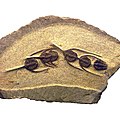| Librostoma Temporal range: | |
|---|---|
 | |
| Asaphus lepidurus | |
| Scientific classification | |
| Kingdom: | Animalia |
| Phylum: | Arthropoda |
| Clade: | † Artiopoda |
| Class: | † Trilobita |
| Subclass: | † Librostoma Fortey, 1990 [1] |
| Orders | |
| |
Librostoma is a subclass of trilobites defined by having a natant hypostome, which is a hypostome (mineralized trilobite mouthpart) that is free from the anterior doublure and aligned with the anterior of the glabella, [4] this is unlike a conterminant hypostome, which is attached to the exoskeleton. [5]
Contents
They are a large and long lasting group, with some of the candidates for the first trilobites being librostomes in the order Ptychopariida; and all post-Devonian [b] trilobites being in the order Proetida, who are librostomes.







